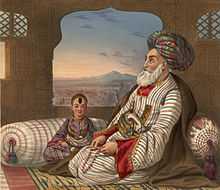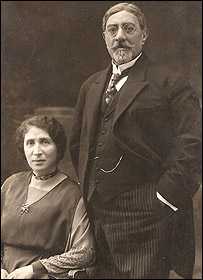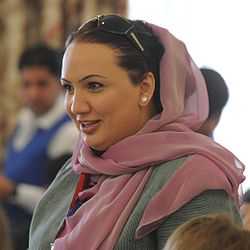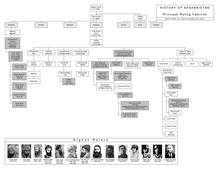Barakzai dynasty
| Barakzai dynasty | |
|---|---|
| Country | Afghanistan |
| Titles | Emir, King |
| Founded | 1826 |
| Founder | Dost Mohammad Khan |
| Final ruler | Mohammad Zahir Shah |
| Current head | Ahmed Shah Khan |
| Dissolution | 1973 |
| |||||
| Total population | |||||
|---|---|---|---|---|---|
| several millions | |||||
| Regions with significant populations | |||||
| Afghanistan, Pakistan | |||||
| Languages | |||||
| Pashto, Dari, | |||||
| Religion | |||||
| Predominantly Sunni Islam | |||||
The two branches of the Barakzai dynasty (Translation of Barakzai: sons of Barak) ruled modern day Afghanistan from 1826 to 1973 when the monarchy finally ended under Mohammad Zahir Shah. The Barakzai dynasty was established by Dost Mohammad Khan after the Durrani dynasty of Ahmad Shah Durrani was removed from power. During this era, Afghanistan saw much of its territory lost to the British in the south and east, Persia in the west, and Russia in the north. There were also many conflicts within Afghanistan, including the three major Anglo-Afghan Wars and the 1929 civil war.
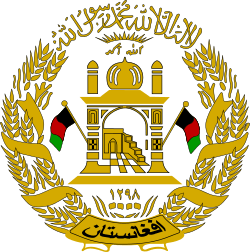 |

History and background
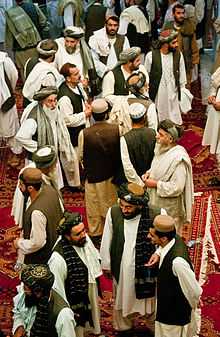 |
| Part of a series on |
| Pashtuns |
|---|
| Kingdoms |
| Religion |
 | ||||||||||||||||||||||||||||||||||||||||||
| History of Afghanistan | ||||||||||||||||||||||||||||||||||||||||||
|---|---|---|---|---|---|---|---|---|---|---|---|---|---|---|---|---|---|---|---|---|---|---|---|---|---|---|---|---|---|---|---|---|---|---|---|---|---|---|---|---|---|---|
| Timeline | ||||||||||||||||||||||||||||||||||||||||||
|
Ancient
|
||||||||||||||||||||||||||||||||||||||||||
|
Medieval
|
||||||||||||||||||||||||||||||||||||||||||
|
Modern
|
||||||||||||||||||||||||||||||||||||||||||
| ||||||||||||||||||||||||||||||||||||||||||
The Barakzai dynasty was the line of rulers in Afghanistan in the 19th and 20th centuries. Following the fall of the Durrani Empire in 1826, chaos reigned in the domains of Ahmed Shah Durrani's Afghan Empire as various sons of Timur Shah struggled for supremacy. The Afghan Empire ceased to exist as a single nation state, disintegrating for a brief time into a fragmented collection of small units. Dost Mohammad Khan gained preeminence in 1826 and founded the Barakzai dynasty in about 1837. Thereafter, his descendants ruled in direct succession until 1929, when King Amanullah Khan abdicated and his cousin Mohammed Nadir Shah was elected king. The most prominent & powerful sub-clan of the Barakzai Pashtun tribe is the Mohamedzai clan, of which the 1826-1973 Afghanistan ruling dynasty comes from.[1]
According to Hyat Khan's history of Afghanistan, from their progenitor Bor Tareen, otherwise known as Abdal, are descended two main divisions: the Zirak and the Panjpai. The term Abdal, however, gradually superseded Bor Tareen and came into special prominence when Ahmad Shah Abdali, commonly known as Durrani, began his career of conquest. The Achakzi were once a branch of the large Barakzai tribe, but Ahmad Shah Durrani was worried over this large tribe as potential competition for control of Kabul’s throne and split the tribe into two separate components and since then the Achakzi have remained distinct and are a separate tribe today. Their original homeland was Maruf District, Kandahar Province.[2][3][4]

Barakzai are also thought to be one of the Lost tribes of Israel and are sometimes associated with the Tribe of Benjamin (Hebrew: בִּנְיָמִין, Modern Binyamin, Tiberian Binyāmîn).[5][6][7][8][9] It's said that Barakzai are the descendants of "Afghana" (born ~ 1000 BC) the grandson of King Saul of the Tribe of Benjamin is considered in Afghan folklore a tribal chief or prince of Bani Israel[10] (Israelite) origin and a progenitor of modern-day Pashtuns (ethnic Afghans),[11][12][13][14][15] the largest ethnic group in Afghanistan and second largest in Pakistan. The ethnonym "Afghan" is believed to derive from his name.[11][12][13][14][15]
Durrani tribe are their closest counters and then next closest to Yusuf Zi (Sons of Joseph) since Yūsuf was Binyāmîn's full brother, and Ephriti (Tribe of Ephraim) and Khattak (Tribe of Menashe) as their last closest in terms of the Lost Tribes of Israel and also in relations because Ephraim and Menashe were the sons of Yūsuf, which makes Ephraim & Menashe the nephew of Binyāmîn, who was the youngest son of Yaʿqūb with Raḥel.[16][17][18][19][20] Even the name Barakzi and its most prominent and powerful sub-tribe of Mohammadzi can be compared with the name of Ashkenazi, who are the Jews descended from the medieval Jewish communities along the Rhine in Germany from Alsace in the south to the Rhineland in the north. The term suffix - zi, the plural of Pashto zay, stands for "descendant", and in Avestan it is similar with zoi, "offspring", which is related to the English word "son".[21] However, research towards validating such claims has been inconclusive.[22][23][24]
Current Khan of Barakzai tribe

Currently, Gul Agha Sherzai is the Khan of barakzai Tribe. He is Senior Advisor to the President of Afghanistan and also Governor of Nangarhar Province.
Barakzai Tribe in District Swabi of Pakistan
A family of Barakzai Tribe is residing in village Tordher of District Swabi of Khyber PukhtoonKhwa.
Mohammadzai
Mohammadzai are the most prominent & powerful sub-tribe of Barakzai, they belong to the branch of the Durrani confederacy, and are primarily centered around Kandahar. They can also be found in other provinces throughout Afghanistan as well across the border in the Pakistan's Balochistan Province.
Musahiban also known as Sultan Muhammed Khel or the Yahya Khel. Descendants of Sultan Muhammed Khan, ruler of Peshawar, brother of Dost Muhammad Khan. Mohammadzai Barakzai are closely related to Amanullah Khan. The family of Nadir and Zahir Shah.
Payendah Khel are descendants of Payendah Khan, head of the Mohammadzai branch of the Barakzai tribe during the reigns of Timur and Zaman Shah, who became rulers with the decline of the Sadozai dynasty.
The Tarzi family is a branch of the Mohammadzai of Afghanistan. Although a smaller branch of the Barakzai ruling dynasty, the Tarzi family has produced some of the most famous and affluent members. The founder of Tarzi family was Ghulam Muhammad Tarzi.

List of Barakzai rulers
- Dost Mohammad Khan (1826 — August 1839)
- Sardar Rahmdil Khan - Ruler of Kandahar & Baluchistan
- Sardar Payinda Khan - Ruler of Kandahar & Baluchistan
- Akbar Khan (December 1842 — 1845)
- Dost Mohammad Khan (1845 — June 9, 1863)
- Sher Ali Khan (June 12, 1863 — May 5, 1866
- Mohammad Afzal Khan (May 5, 1866 — October 7, 1867)
- Mohammad Azam Khan (October 7, 1867 - February 21, 1868)
- Sher Ali Khan (February 21, 1868 — February 21, 1879)
- Mohammad Yaqub Khan (February 21, 1879 — October 28, 1879)
- Abdur Rahman Khan (August 11, 1880 — October 3, 1901)
- Habibullah Khan (October 3, 1901 — February 20, 1919)
- Amanullah Khan (February 28, 1919 — January 14, 1929)
- Queen Soraya Tarzi (w. of King Amanullah Khan) (November 29, 1899 - April 20, 1968)
- Sardar Ghulam Muhammad Tarzi - Poet, Ruler of Kandahar & Baluchistan.
- Inayatullah Khan (January 14, 1929 — January 17, 1929)
- Mohammed Nadir Shah (October 17, 1929 — November 8, 1933)
- Mohammed Zahir Shah (November 8, 1933 — July 17, 1973)
Heads of the House of Barakzai since 1973
- King Mohammed Zahir Shah (July 17, 1973 — July 23, 2007)
- Crown Prince Ahmad Shah Khan (July 23, 2007 — Present)
The Emirate of Western Baluchistan
- Bahram Khan Barkzai (Baranzahi) (1903—1919)
- Mir Dost Mohmmad Khan Baranzahi (Barakzai) (1919—1928)
Nawabs of Kurwai and Basoda
Barakzai Feroze Khel
- Muhammad Dalayer Khan (founder — 1730)
Kurwai
- Muhammad Izzat Khan
- Hurmat Khan
- Muhammad Akbar Khan
- Muhammad Muzaffar Khan
- Muhammad Najaf Khan
- Munawar Ali Khan
- Sarwar Ali Khan
- Shahed Ali Khan
- Zafar Ali Khan
- Niaz Ali Khan Bahadur
Basoda
- Ahsanullah Khan d.1786
- Bakaullah Khan
- Asad Ali Khan
- Omar alikhan
- Haider Ali Khan (became Nawab in 1897)
- Ayub alikhan
- Masood alikhan ( last Nawab in 1947)
- ANWAR ALI KHAN
- SIDDIQ ALI KHAN
Languages
The principal language of Barakzai is Pashto. Formerly, Dari Persian was used as the language for records and correspondence; until the late nineteenth century tombstones were also inscribed in Dari. The language of the Barakzai tribes in Pishin, Quetta, Gulistan and Dukki (Distt. Loralai) is just like the language spoken in Kandahar. Those who have settled away from Pishin speak local languages (Pushto), such as Multani or Saraiki in Multan, Hindko in Hazara, Urdu in Bhopal and Sindhi in Sindh. Barakzai, a dialect of Pashto, is the language spoken by Harnai Barakzai.[25][26][27]
See also
- Barakzai
- Mohammadzai
- Theory of Pashtun descent from Israelites
- Pashtunistan
- Pakthas
- European influence in Afghanistan
- Anglo-Afghan War
- Loya jirga — "grand jirga", a large congress called to discuss a particularly important event
- Meshrano Jirga — "elders' jirga", the upper house of the Afghan legislature[28][29][30]
References
- ↑ "Afghanistan". CIA. The World Factbook. Retrieved 2010-08-25.
- ↑ http://books.themajlis.net/book/print/538 Shariat and Tasawwuf
- ↑ http://www.islamicrepublicofafghanistan.com/the-legendary-qais-abdur-rashid/ The Legendary Qais Abdur Rashid
- ↑ http://www.guardian.co.uk/world/2010/jan/17/israel-lost-tribes-pashtun Pashtun clue to lost tribes of Israel: Genetic study sets out to uncover if there is a 2,700-year-old link to Afghanistan and Pakistan
- ↑ http://www.kulanu.org/pathan/israeliteorigins.html Pashtun Bani Israelite Origins
- ↑ http://www.dangoor.com/74069.html Hebrew Pashtun Article 1
- ↑ http://www.dangoor.com/74039.html Hebrew Pashtun Article 2
- ↑ Alden Oreck, The Virtual Jewish History Tour: Afghanistan from Jewish Virtual Library
- ↑ Video on YouTube
- ↑ http://wn.com/Bani-Israel
- ↑ 11.0 11.1 Socio-economic Behaviour of Pukhtun Tribe By Dipali Saha, Dipali Saha - 2006 - 282 pages - Page 124.
- ↑ 12.0 12.1 India and the Afghans: a study of a neglected region, 1370-1576 A.D., Amrendra Kumar Thakur, Janaki Prakashan, 1992 - 231 pages, Covers the history of Bihar during the Afghan rule in India. Page 2 & 9.
- ↑ 13.0 13.1 Journal of the Research Society of Pakistan, Volume 22, Research Society of Pakistan, 1985 - Page 4.
- ↑ 14.0 14.1 Pukhtun economy and society: traditional structure and economic development in a tribal society, Akbar S. Ahmed, Routledge & Kegan Paul, 1980 - 406 pages - Page 128 & 129.
- ↑ 15.0 15.1 Niamatullah's history of the Afghans , Volume 1, Niʻmat Allāh, Nirod Bhusan Roy, Santiniketan Press, 1958 - Page 5 & 9.
- ↑ Amir Mizroch (2010-01-09). "Are Taliban descendants of Israelites?". The Jerusalem Post.
- ↑ "Israelites fund scholarship to study DNA link to Taliban"
- ↑ Sachin Parashar (2010-01-11). "Lucknow Pathans have Jewish roots?". Times of India.
- ↑ Rory McCarthy (2010-01-17). "Pashtun clue to lost tribes of Israel". The Observer.
- ↑ https://www.jewishvirtuallibrary.org/jsource/vjw/Afghanistan.html
- ↑ http://www.nps.edu/Programs/CCs/FamilyTrees.html
- ↑ Amir Mizroch (2010-01-09). "Are Taliban descendants of Israelites?". The Jerusalem Post.
- ↑ Sachin Parashar (2010-01-11). "Lucknow Pathans have Jewish roots?". Times of India.
- ↑ Rory McCarthy (2010-01-17). "Pashtun clue to lost tribes of Israel". The Observer.
- ↑ Pakistan and the emergence of Islamic militancy in Afghanistan By Rizwan Hussain Page 16
- ↑ page 64 India and Central Asia By J. N. Roy, J.N. Roy And B.B. Kumar, Astha Bharati (Organization)
- ↑ Study of the Pathan Communities in Four States of India, Khyber.org (retrieved 30 January 2008)
- ↑
- ↑
- ↑
